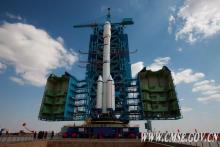"Its name ... speaks for a dream home the Chinese have long envisioned in the sky. In Chinese folklore, a heavenly palace often refers to the place in outer space where deities reside," the official Xinhua radio station announced, according to Reuters. The Tiangong 1 is an unmanned spacecraft supporting a science laboratory, and is the first stage of the Chinese space station's orbital construction. The second phase will happen in several weeks, when the next component is launched aboard Shenzhou 8 and the two are fit together. "Space docking tests conducted with the Tiangong 1 will provide experience for the building of a permanent manned space station around 2020," reported a mission spokeswoman.
The launch was widely broadcast around China, lauded as a major success for the Chinese people and the perfect event to give greater importance on October 1st, China's National Day. However, recent incidents with China's rapidly developing rail system has thrown a shadow over Tiangong's launch. In July a high-speed rail collision killed 40 people, and last week another train collision injured 200. Despite that, many people are hopeful for the future, and China shows a greater vision for its nation and its place in the world.
Other than China's proposed building of a space station by 2020, they've also announced plans for a manned mission to the moon, and a moon rover that will explore the lunar surface much as we've done on Mars. By comparison, President Barack Obama has announced plans for manned space flight, a public/private cooperation between NASA and a number of corporations. His proposal includes another manned mission to the moon by 2025, and a possible manned mission to Mars by 2030. However, NASA won't even be testing their touted deep-space mission rocket until 2017. Though the U.S. presence in space is still unmatched, China seems to be pressing their economic advantage toward a greater presence as well.
